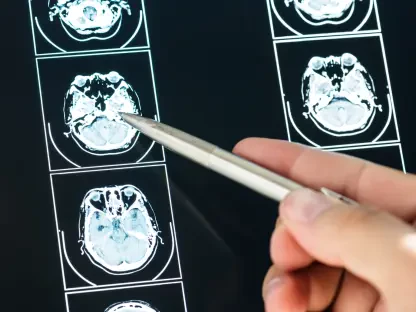Listen to the Article
Neurotechnology seems to advance by leaps and bounds every day. And one frontier that stands out among the rest is the world of brain-computer interfaces.
What was once thought of as “the stuff of science fiction” is quickly becoming a reality for many. Today, scientists are increasingly developing innovative ways to command machines by thought or get an implant to restore and possibly even enhance brain function.
This article discusses technologies that provide a link between mind and machine and explores a future where the brain’s electrical signals become the language that enables interaction with computers, overcomes disabilities, and taps into the potential of the human mind.
Start reading to:
Explore the value of brain-computer interfaces and how they work.
Learn more about ethical, societal, and technical challenges.
How Brain-Computer Interfaces Work
There are four steps that are broadly applicable to most Brain-Computer Interfaces: Measure, interpret, encode, and deploy (MIND in short).
The first step (measure) revolves all around recording brain signals. Devices like brain implants use razor-thin electrodes to pick up high-resolution data from specific brain regions. This precision is vital for tasks like controlling finger movements in a prosthetic hand or operating a computer.
Another electrical method is electroencephalography, where head-worn devices use scalp electrodes to record brain activity. Because these electrodes are outside the skull, the data can be a bit noisy and less precise, but electroencephalographies work great for checking the overall brain state, like focus, engagement, and sensory input. Engineers have even used electroencephalography to boost focus and enable typing.
But electricity isn’t the only way to monitor brain activity. Neurotechnologies like functional Magnetic Resonance Imaging and functional Near-Infrared Spectroscopy. While these methods work on a slower timescale, they can reach deeper into the brain and give a more complete view of overall function.
The second and third steps seek to interpret what the recorded data means and encode it into information a computer can use. To do this, patterns in brain activity must be found, which is most often done by machine learning.
To help someone communicate by turning thoughts into words, researchers first ask the subject to think of a word while recording brain activity in their language areas. This step is repeated several times for each word, so the data can be checked for patterns. By layering the data from each trial, unique brain activity patterns for every word emerge. For example, the pattern for “dog” looks very different from the one for “cat.”
Once the training is done, the user can think of any one of the trained words in any order they want. The computer then matches their current brain activity with the known patterns and displays the intended word on the screen.
The last part of the MIND acronym is “Deploy”. This is the step where something is actually done with the data that has been processed in the previous steps. In the decoding thoughts example, the “deploy” step is where the word the user wants to say is displayed on the screen for everyone to see. If the goal is to control a prosthetic hand, the “deploy” stage is where the robot is told where to go and which fingers to move.
Ethical, Societal, and Technical Challenges
Brain-computer interfaces are moving fast and sparking big ethical debates, such as issues with informed consent, patient autonomy, and how they shape the patient’s identity. These concerns are front and center, making the need to meet regulatory demands essential.
Brain-computer interfaces also touch on data privacy, medical devices, and artificial intelligence, with no unified legal framework for neurotechnology yet. There are public doubts about mind-reading and fears of data theft that lead many people to worry about privacy and cognitive liberty, creating a tricky balance between pushing innovation forward and ensuring that safety remains a top priority.
Moreover, being open and transparent is essential for building trust, even though the rules—which include the Food and Drug Administration and European Medicines Agency regulations, strict data privacy guidelines, and ethical questions about cognitive liberty and enhancement—can be quite complex.
That’s why the industry needs clear standards to balance cutting-edge innovation with basic human rights. And on a deeper level, brain-computer interfaces blur the lines between mind, body, and technology, raising fascinating questions about what it truly means to be human.
On the technical side, one of the biggest challenges in brain-computer interface technology is dealing with the brain’s natural variability. This means that the patterns of neural activity change from one day to the next, meaning a system that is trained to recognize a user’s intentions on one day might not work as well on the following day.
Neuralink’s first attempt at implanting its chip in a human skull ran into an unexpected problem when the device began detaching from the patient’s brain. In February, Noland Arbaugh underwent surgery to have a Neuralink chip attached to his brain, only to see its functionality decrease within just a month. According to Neuralink’s blog post, an undisclosed number of these threads “retracted from the brain, resulting in a net decrease in the number of effective electrodes,” which in turn reduced the device’s bits per second—a key measure of how well the implant could perform its tasks.
Conclusion
Although the idea of merging humans with machines has been around since the 1960s, brain-computer interface technology has now moved into the clinical trial stage. Researchers are now focusing on restoring key functions such as communication, mobility, and sensation for people with severe disabilities or neurodegenerative disorders, marking a significant shift from theoretical ideas to real-world applications.
It is clear that brain-computer interfaces are not only pushing the boundaries of scientific progress but also challenging and reshaping our very understanding of what it means to be human. By tackling these challenges directly and encouraging open discussions, society can work toward unlocking the full potential of brain-computer interfaces while ensuring that the fundamental values defining human identity remain protected. As mind-machine interaction moves from concept to reality, the responsibility falls on us to guide its development in a way that is both ethical and forward-thinking.









